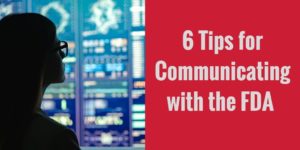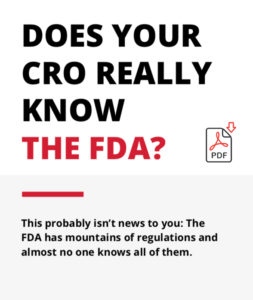6 Tips for Communicating with the FDA During Product Development
 If you are reading this, you are likely in the process of developing a new medication or medical device for FDA approval. Maybe your product is nicely progressing through pre-clinical trials and you’re in the process of building your clinical trial protocols. Maybe you’re evaluating the pharmacology and toxicology data, or maybe you’ve already submitted the IND. But have you reached out to your Regulatory Project Manager (RPM) at the FDA yet?
If you are reading this, you are likely in the process of developing a new medication or medical device for FDA approval. Maybe your product is nicely progressing through pre-clinical trials and you’re in the process of building your clinical trial protocols. Maybe you’re evaluating the pharmacology and toxicology data, or maybe you’ve already submitted the IND. But have you reached out to your Regulatory Project Manager (RPM) at the FDA yet?
Communicating with the FDA is an important aspect of clinical research and provides the opportunity to assure your research is following all regulatory and safety guidelines. The RPMs are the primary points of contact between you and the FDA and will facilitate the resolution of conflicts or concerns between you and the review team. They can also offer advice throughout the development process on topics ranging from clinical and statistical protocols to safety and product quality.
Why wouldn’t you want to use this resource? After all, the FDA does have the final say on whether or not your product will be approved. Having the ability to consult with them and maintain timely communications can result in greater efficiency in bringing your product to market. Although there are no formal rules on how to cultivate this relationship, there are some best practices that can enhance this collaboration and help you in achieving approval.
Here at Princeton Pharmatech, our experts have spent decades working in the drug development industry, gaining knowledge and insight about working collaboratively with the FDA to obtain approval. These are some of our recommendations for streamlining communications and building positive rapport with the regulatory agency deciding the fate of your product.
1. The earlier, the better.
One of the keys to successfully getting your product from a vision to the market is maintaining frequent communications with the FDA, especially with first-in-class drugs. The earlier in the process this correspondence begins, the better off your company will be. We recommend meeting with them prior to submitting your IND to be sure transitioning from animal to human trials is smooth and in compliance with safety regulations. If you have already submitted your IND but have not yet begun communicating with the FDA, we recommend reaching out to them as soon as possible.
2. Have a communication strategy.
The FDA provides the option of developing a communication strategy with set timelines to be sure your product is on the right track. Although not necessary, this formal communication plan can be a great way of establishing standards and expectations on the timing and format of interactions between you and the FDA program managers. If you do not create a strategy with the FDA, at least develop a plan within your own development team for when and how you will contact them for advice or review. Having a communication protocol will make it easier when it comes time for these meetings and pave a smooth road to approval.
3. Include at least one statistician on your communication team.
The robustness of your data will be an important factor when seeking FDA approval. You need a person on your communication team that can describe the statistical methods and results involved in demonstrating your product’s safety and efficacy. Your statisticians will play a significant role in developing the statistical analysis plan (SAP) which must be reviewed by the FDA. Including at least one on your communication team will guarantee all statistical requirements are met throughout the process.
4. Include at least one team member that comes from a medical background.
When discussing your potential product, the FDA will expect a description of the science behind it and the therapeutic pathways it uses to treat the target condition. Including an experienced medical researcher ensures your communication team will be ready to answer any questions or concerns encountered during the development process.
5. Be clear and concise in your communications.
Whether you are attending a meeting or corresponding through email, be an effective communicator. Keep your questions and responses clear and direct without complicating them with unnecessary details. Misunderstandings and confusion can slow the process or impede your product from seamlessly progressing to the market.
6. Always attend meetings well-prepared and equipped with all the needed documents.
At certain milestones in the clinical research process, you will need to submit documentation regarding safety and product quality, and schedule meetings with the FDA to share critical results. Be sure you submit all necessary documentation in a timely manner, and arrive at all meetings prepared. We recommend preparing a meeting folder containing all of the prevalent information and study data that can be referenced during correspondence.
The drug development process is convoluted and lengthy, providing numerous opportunities for blunders or miscalculations. Communicating with FDA project managers is a tremendous resource for maintaining regulatory compliance and keeping your product on track for approval. It also provides the opportunity to build a positive working relationship with the regulatory agency that approves your product for the market. If you have questions or concerns about these communications or the FDA approval process in general, schedule a consultation with one of our experts today!
Next Steps:
Read our analysis on other FDA Guidelines.
Schedule a one-on-one call to see how Princeton can help solve your challenges.
See how Princeton’s services can help you.
Subscribe to our blog to stay up to date.
